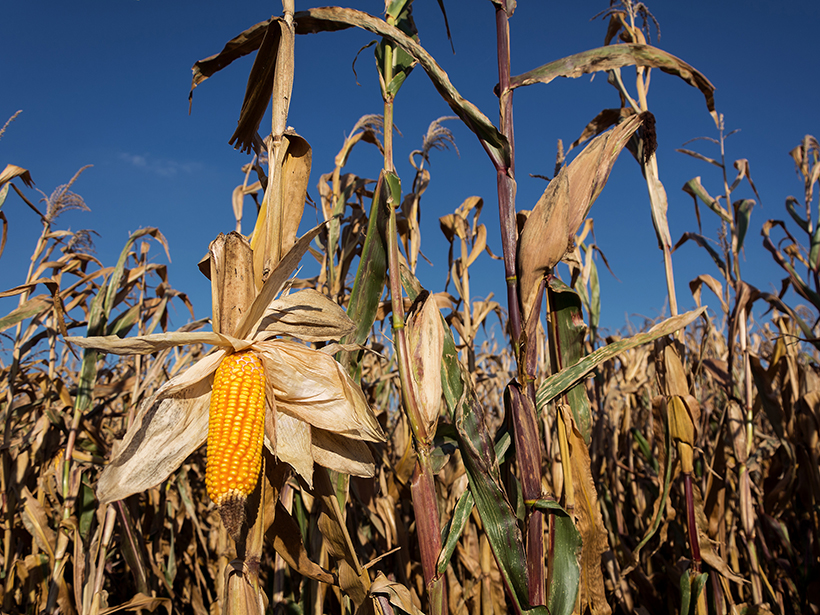Negative emissions technologies, which remove carbon dioxide (CO2) from the atmosphere, could halt or even reverse the process of climate change. But not, new research highlights, without major consequences.
University of Virginia doctoral candidate Jay Fuhrman and associate professor of engineering Andres Clarens said that full-scale negative emissions technology would double global usage of water and fertilizer and require vast amounts of land and energy. Fuhrman and Clarens presented their research in December in a poster session at AGU’s Fall Meeting 2019 in San Francisco, Calif.
Going Negative
Even if countries immediately curtail their CO2 emissions, negative emissions are crucial for nations to meet emissions guidelines set by the Paris Agreement for 2050 and to stay below 1.5°C or 2°C of warming by 2100.
Clarens and Fuhrman considered the future of negative emissions with integrated assessment models, complex economic models that integrate projections of climate change, land use, and energy systems. Using one such model, they predicted the scale of negative emissions needed to keep Earth below 1.5°C or 2°C of warming, as well as what mix of technologies would be the most effective.
One heavily studied technology is bioenergy with carbon capture and storage (BECCS), which involves crops being converted into biofuels and burned for energy. The CO2 released is then captured and pumped beneath the ground. “Basically,” Clarens said, “it’s running climate change in reverse.”
But the technology is not without its drawbacks. According to a 2018 analysis in Nature Communications, full-scale implementation of BECCS would necessitate 380–700 hectares of land devoted to bioenergy crops, up to 50% of the area of present-day cropland.
The model predicted that the scale of negative emissions necessary to keep warming under 1.5°C would double global water use.
Most modeling of negative emissions relies primarily on BECCS, but Fuhrman and Clarens sought to model a mix of technologies. That mix includes direct air capture, a mechanical process of scrubbing CO2 from the open atmosphere. Direct air capture doesn’t have the land and fertilizer requirements of BECCS, but it uses vast amounts of energy and water. Models anticipate that the technology will grow more efficient over time, but Clarens noted that given how dilute CO2 is in the atmosphere, there are inherent limits to that efficiency.
Using a mix of BECCS, direct air capture, and other negative emissions technologies, the model created by Clarens and Fuhrman predicted that the scale of negative emissions necessary to keep warming under 1.5°C would double global water use.
“That water probably doesn’t exist,” said Clarens. “The amount of fertilizer we would need by mid-century would be about twice what we produce today, which is possible, but there’s a huge implication to doing that.”
Bioenergy with carbon capture, he said, could have particularly huge impacts by displacing food crops. “When we passed the bill to have corn ethanol in this country, it led to all kinds of food instability in Mexico because the cost of tortillas had gone up overnight. That was a drop in the bucket compared to what we’re talking about today,” said Clarens.
Isabela Butnar, a bioenergy systems researcher at University College London unaffiliated with the research, agreed. “We don’t really, actually understand the full consequences of the massive rollout of bioenergy. It could lead to water problems and to competition for land and land use change and deforestation.”
However, Butnar added, “biomass for energy doesn’t need to be a cultivated crop. It could be agricultural residuals, for example, like corn or wheat straw,” which wouldn’t destabilize food prices.
Pondering the Plan
Clarens hopes his research provokes more conversation about the potential impacts of negative emissions. “If we decide yes, we have an appetite [for negative emissions], that’s fine. It just means that our ecosystems are probably going to look very different in 30 or 40 years than they do today. We’re going to have a ton more agricultural land, and we’re going to have energy systems that are dominated by supporting this industry.”
His findings, he said, underline the importance of stopping the emission of CO2 immediately because the more carbon that is emitted now, the more negative emissions will be needed in the future.
“The piece that people miss is that the plan has become increasingly more and more bonkers.”
“World leaders have always been like, ‘Well, I’m not going to do anything because I’ll just wait for the next climate meeting and see what the plan is then,’” said Clarens. “The piece that people miss is that the plan has become increasingly more and more bonkers.”
Butnar agrees, noting that many climate projections involve an “overshoot” of warming above 2°C before future negative emissions bring temperatures back down. The models, she said, don’t fully account for the damages of climate change, including extreme weather and natural disasters. Looking at the model, she said, “it looks okay to overshoot and then come back with negative emissions, while in reality we don’t know what happens. We already see the consequences of climate change more and more. Is it fair to kind of rely on later mitigation and do less now?”
“Look: There is no silver bullet,” said Butnar. “There is nothing which will work without consequences. Are we prepared to pay?”
—Jesse Kathan ([email protected]; @jessekathan), Science Communication Program Graduate Student, University of California, Santa Cruz
Citation:
Kathan, J. (2020), Some plans to reverse climate change could double water use, Eos, 101, https://doi.org/10.1029/2020EO139303. Published on 30 January 2020.
Text © 2020. The authors. CC BY-NC-ND 3.0
Except where otherwise noted, images are subject to copyright. Any reuse without express permission from the copyright owner is prohibited.

